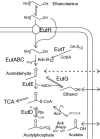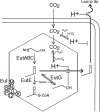Conserving a volatile metabolite: a role for carboxysome-like organelles in Salmonella enterica
- PMID: 16585748
- PMCID: PMC1447003
- DOI: 10.1128/JB.188.8.2865-2874.2006
Conserving a volatile metabolite: a role for carboxysome-like organelles in Salmonella enterica
Abstract
Salmonellae can use ethanolamine (EA) as a sole source of carbon and nitrogen. This ability is encoded by an operon (eut) containing 17 genes, only 6 of which are required under standard conditions (37 degrees C; pH 7.0). Five of the extra genes (eutM, -N, -L, -K, and -G) become necessary under conditions that favor loss of the volatile intermediate, acetaldehyde, which escapes as a gas during growth on EA and is lost at a higher rate from these mutants. The eutM, -N, -L, and -K genes encode homologues of shell proteins of the carboxysome, an organelle shown (in other organisms) to concentrate CO(2). We propose that carboxysome-like organelles help bacteria conserve certain volatile metabolites-CO(2) or acetaldehyde-perhaps by providing a low-pH compartment. The EutG enzyme converts acetaldehyde to ethanol, which may improve carbon retention by forming acetals; alternatively, EutG may recycle NADH within the carboxysome.
Figures










References
-
- Badger, M. R., and G. D. Price. 2003. CO2 concentrating mechanisms in cyanobacteria: molecular components, their diversity and evolution. J. Exp. Bot. 54:609-622. - PubMed
-
- Bobik, T. A., G. D. Havemann, R. J. Busch, D. S. Williams, and H. C. Aldrich. 1999. The propanediol utilization (pdu) operon of Salmonella enterica serovar Typhimurium LT2 includes genes necessary for formation of polyhedral organelles involved in coenzyme B12-dependent 1,2-propanediol degradation. J. Bacteriol. 181:5967-5975. - PMC - PubMed
-
- Bradbeer, C. 1965. The clostridial fermentations of choline and ethanolamine. I. Preparation and properties of cell-free extracts. J. Biol. Chem. 240:4669-4674. - PubMed
Publication types
MeSH terms
Substances
Grants and funding
LinkOut - more resources
Full Text Sources
Other Literature Sources
Molecular Biology Databases

